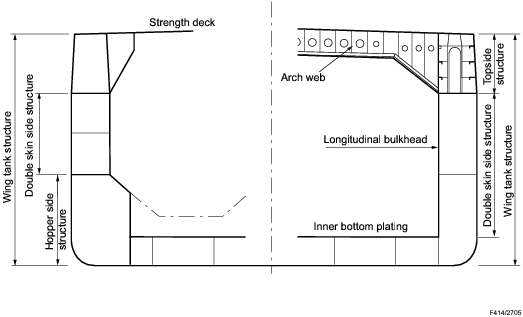
Section
1 General

1.1 Application
1.1.3 In addition
to cases where direct calculation methods are specifically required
by the Rules, LR will consider alternative arrangements and scantlings
which have been derived by direct calculations in lieu of specific
Rule requirements. All direct calculations are to be submitted for
examination.
1.1.4 For the application of these Rules under Canadian or United States
registration, the ship requires to have load lines assigned in accordance with the
requirements of the relevant inland Load Line Regulations.
1.1.5 The joint
requirements, required for a ship to transit the St. Lawrence Seaway
between Montreal and Lake Ontario and between Lake Ontario and Lake
Erie are given in the publication "The Seaway Handbook", details of
which can be found on the web page: http:\\www.greatlakes-seaway.com

1.2 Structural configuration
1.2.2 Longitudinal
framing is to be adopted at the strength deck outside the line of
openings and topside area and double bottom in way of the cargo holds.
1.2.3 Transverse
or longitudinal framing may be adopted for the side wing tank structure.
1.2.4 Ships complying
with these requirements will require to have a collision bulkhead,
located as in Ch 4, 9.3 Collision bulkhead 9.3.1, an after
peak bulkhead, generally enclosing the sterntube in a watertight compartment
and a watertight bulkhead at the forward end of the engine room. Additional
bulkheads or equivalent supporting structures are to be arranged in
order to provide adequate transverse strength.

1.3 Class notations
1.3.1 In general, ships complying with the requirements of this Chapter will be
eligible to be classed 100A1 Great Lakes Bulk Carrier with the specified
operating service area notation for Service on the Great Lakes and River St.
Lawrence and where applicable, with the descriptive note, Self Unloading
stated in column 6 of the Register Book.
1.3.2 Ships intended
to be operated only in suitable areas or conditions, which have been
agreed by the Committee, as defined in Ch 1, 2 Governance of the Rules for Ships, will receive individual consideration
on the basis of the Rules, with respect to the environmental conditions
agreed for the design basis and approval.
1.3.3 The Regulations
for classification and assignment of class notations are given in Pt 1 Regulations of the Rules for Ships to which reference
should be made. The requirements for New Construction Surveys are
given in Pt 1, Ch 2, 3.2 New construction surveys of the
Rules for Ships.
1.3.7 ShipRight
notations SDA, FDA and CM are, in general,
not applicable.
1.3.8 The notation LI will be assigned where an approved loading instrument has been
installed.

1.4 Definitions
1.4.3
Arch
Web is a strength deck transverse in cargo hold between the
cargo hatches, see
Figure 4.1.7 Nomenclature.

Figure 4.1.7 Nomenclature
1.4.4
Strength
Deck is the uppermost continuous weather deck, occasionally
referred to as the Upper Deck or Spar Deck, see
Figure 4.1.7 Nomenclature.
1.4.5
Engine
Room Gangway Doors. Side shell port and/or starboard doors
in way of the engine room for stores use.

1.5 Equivalents
1.5.1 Alternative
arrangements or fittings, which are considered to be equivalent to
the requirements of these Rules, will be accepted.

1.6 Inspection, workmanship and testing procedures

1.7 Rounding policy for plate thickness
1.7.1 Where plating thicknesses as determined by the Rules are required to be rounded, then
this should be carried out to the nearest half millimetre, with thicknesses 0,75 mm
and 0,25 mm being rounded up.
For example,
- for 10,75 ≤ t < 11,25 mm, the Rule required
thickness is 11,0 mm;
- for 11,25 ≤ t < 11,75 mm, the Rule required
thickness is 11,5 mm.
|